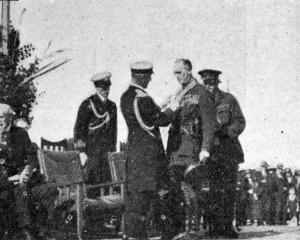
The weather conditions were not quite perfect, but there was a good attendance at the beach, and everything went off well. A display of life-saving was given, and a number of children’s races were held. The bun and treacle competition was very amusing. The President of the Surf Bathing Club, Mr Mark Cohen, delivered an opening speech, in the course of which he referred to the great increase in the number of bathers. Over 300, inclusive of 147 ladies, were on the club’s membership roll, and came from all parts of the city and suburbs. Mr Cohen said that the facilities for utilising the beach should be increased so that every advantage could be taken of the comparatively brief opportunities compared with other bathing resorts, where sun and wind and water were in harmonious conjunction. He was much disappointed at the action of the City Council in seeking to replace the pavilion with a structure that would be costly compared with the minimum of comfort it was designed to confer. His idea had always been that "shelters", in the ordinary sense of the term, unornamental and little more than plain serviceable structures to break the force of prevailing high winds, and to enable people to keep themselves dry until a shower had passed over, together with those "conveniences" which should be everywhere that people congregated in large numbers; a contrivance for keeping the family billy boiling; and for the rest every kind of amusement that the juvenile heart delighted in — these were the things that the public desired. For the money that the council proposed to expend on the rehabilitated pavilion three commodious and comfortable ‘‘shelters’’ and appurtenances could be erected at different points on the beach frontage. Mr Cohen, before concluding, remarked that the club’s executive would always lay itself out to popularise the beach for the children; where the children went the parents would also go.
• Saturday was a red letter day in the history of Port Chalmers, the occasion being a fete promoted by the residents in aid of the Red Cross funds. The people had been preparing for this for weeks, and consequently an elaborate programme was carried out. About 2 p.m. a procession took place, and, after traversing the main streets of the borough, proceeded to the Mussel Bay Domain. The procession was led by the Dunedin Highland Pipe Band, then came the Fire Brigade, the Red Cross lorries, the Dunedin High Street School Fife and Drum Band, Mrs Murray’s and Mr Sykes’s Highland dancers, on a lorry, Mr Coleman’s lorry heading a whole squad of little girls dressed as Red Cross nurses, and Mr Stevenson’s lorry with a similar number of Red Cross girls, and the Druids in regalia. After these came the tradesmen’s displays, which were subsequently judged in a competition arranged for them. The domain was a scene of much activity, and it was easy to notice that old and young alike were out to do their utmost to raise as much money as possible for the Red Cross Fund. From almost every direction visitors were confronted by collectors, who did good business. The gate receipts amounted to over £40, and this should give some idea of the crowd present. It is estimated that over 1000 people were present, and they were admirably catered for by those whose duty it was to collect money. A programme of running events for children was soon in progress, and provided a great deal of amusement for the adults. — ODT, 3.12.1916.
• COPIES OF PICTURE AVAILABLE FROM ODT FRONT OFFICE, LOWER STUART ST, OR WWW.OTAGOIMAGES.CO.NZ












